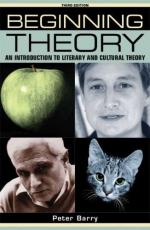|
This section contains 455 words (approx. 2 pages at 400 words per page) |

|
Lesbian/gay criticism Summary and Analysis
Lesbian/gay literary theory does not appear until the 1990s. It appears initially in lesbian and gay studies sections of mainstream bookstores, academic catalogs and undergraduate courses. The field is multi-disciplinary but cultural issues predominate. Its defining trait of sexual orientation is the basis for a "fundamental category of analysis and understanding." Its social and political purpose resists homophobia, heterosexism and socially acceptable heterosexual primacy. Two trends of thought develop into either lesbian feminism or libertarian lesbianism. Lesbian feminism becomes a subset of feminist criticism in the 1980s before developing independently. Classic feminism transcends race, class and sexual orientation which diminish lesbianism. In reaction, lesbian feminists claim lesbianism is essential to feminism. They claim any other position encourages male exploitation. To bridge a gap between lesbian and heterosexual feminists Adrienne Rich prefers a "lesbian continuum" that tolerates...
(read more from the Lesbian/gay criticism Summary)
|
This section contains 455 words (approx. 2 pages at 400 words per page) |

|




